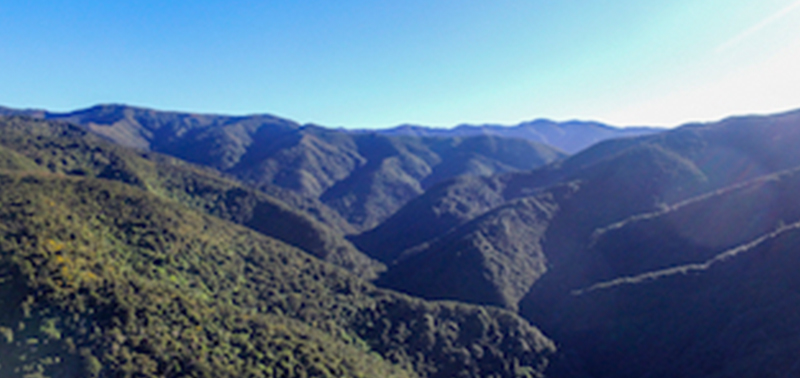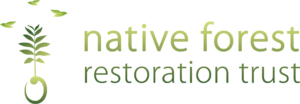The Facts
We New Zealanders consistently rate our natural environment as being very important to us in any survey looking at people’s values. NFRT's experience is that Kiwis are highly motivated to protect our wild places for a variety of reasons, not least of which is a concern about the impact humans are having on the world we live in.
Our impact on the environment
New Zealand's environment is special. Having been isolated from the rest of the world for around 80million years, our plants and animals have slowly evolved into unique forms, filling ecological niches in unusual ways.
When humans first arrived in Aotearoa around 1000 years ago they found it inhabited by peculiar flightless birds, giant invertebrates, and plants - some having survived more or less unchanged since Gondwanan times. These unique creatures that had never seen humans before were easily hunted to extinction. And large parts of the ancient forest were felled.
As if the first 800 years (or so) of human presence weren't difficult enough for wildlife that had been left alone for a million years, the 200 years since Europeans first settled here saw terrifyingly rapid changes.
Forest clearance; wetland drainage; extinction of native species through over-hunting; introduction of alien (non-native) species, both deliberate and accidental: these have all taken their toll on our natural environment. By the late 1800s, some people were starting to realise the consequences of these changes to New Zealand's biota, but it wasn't until the 20th century that steps began to be taken to protect land with the primary aim of conservation of wildlife and habitats.
Looking after our
back yard

Today, over 30% of our total land area is legally protected conservation land. That seems a lot until you look at the map and see that the vast majority of it is in mountainous or otherwise relatively inaccessible areas. In other words, not “productive” land. If you think about it in terms of a garden, it’s easy to set aside the stony bit at the end of the section that’s too hard to work - and call it your wilderness area. But that doesn’t mean it's an ideal refuge for the frog that lived in the swampy bit you drained or a great home for the gecko whose tree you cut down.
Why does it matter?
Many of our native plants and animals are endemic (they are only found in New Zealand) including over 80% of our plants, 90% of our insects, all our reptiles, and all our terrestrial mammals. This makes them particularly vulnerable to habitat loss. Already, more than 75 species have become extinct since humans first came to Aotearoa – that we know of.
It is perhaps excusable that New Zealand’s early settlers were such fervent forest-fellers, given their need for shelter and security. The lowlands in particular have been extensively impacted by land clearance and logging, and through the effects of non-native species introduced by the settlers. This has led to fragmentation of our indigenous lowland, wetland and coastal habitats and a bias towards alpine and upland habitats in our public conservation land.
What few patches remain of these important and unique lowland ecosystems have become isolated from one another, increasing their vulnerability. If one patch becomes damaged or is destroyed, many species cannot move across the intervening land to find another patch of their habitat, and so you get local extinctions, and sometimes species extinctions.
In addition to the effects on wildlife, our natural habitats provide valuable “ecosystem services” that we are foolish to disrupt and ignore. Forests and wetlands are major carbon sinks, helping to regulate our climate and producing the oxygen we breathe; forests stabilise soils, reducing the risk of further erosion whilst providing biodiversity and water quality benefits; wetlands clean water and mitigate flood risk; and our natural environment provides cultural and social benefits and is one of the major reasons tourists come to New Zealand.
Scenically, our public conservation land appears beautiful and unspoiled. In reality, our wildlife
and habitats are struggling to cope with the devastating changes humans have made in
the last 1,000 years or so.
Forests
Native forests and shrublands cover approximately 9 million hectares of land in New Zealand, roughly 33% of total land area. This has reduced from more than 80% of total land area before the arrival of humans. Much of what remains has been heavily modified and is not representative of former diversity.
With over 5 million of the remaining 6.5 million hectares of native forest existing on protected conservation land, we could be forgiven for being complacent about the conservation of our forests. However, most of this protected forest is located in upland areas.
New Zealand’s lowland forests, particularly coastal/duneland and river margin/wetland forests, are under-represented in legally protected land.
- Only 2% of our original kahikatea forest is thought to remain, most of it in fragments on private land.
- Between 1974 and 2002, the proportion of forest land occupied by endemic birds (in other words, birds found nowhere else in the world) had reduced in the North Island from 16% to 5%. In the South Island, it declined from 23% to 16%.
- Kiwi, which currently number around 70,000, are declining at a rate of 2% per year.
- In the Manawatū-Whanganui region alone, ancient lowland kahikatea forest has been reduced to less than 5% of its former extent. And between 1996 and 2012, 89,000 hectares of indigenous forest and scrub was converted to exotic (plantation) forest and exotic (eg rye grass) pasture.
Wetlands
In New Zealand, wetlands support the greatest concentration of wildlife of any of our habitats. They also purify water, prevent floods and erosion, store carbon, provide resources like peat and flax, process nutrients, act as nurseries and offer recreation and aesthetic value.
When people first arrived in Aotearoa, wetlands covered some 9% of the land area - about 2.4 million hectares. Around 90% of our wetlands have been destroyed since 1850. Even today, our wetlands still face drainage, clearance, pollution, choking sediment and invasive weeds.
- Over the 15 year period from 2001 to 2016, 13% of the total area of New Zealand’s remaining wetlands was lost.
- Less than 250,000 hectares of our original wetlands now remain.
- In the North Island, less than 5% of our original wetlands survive.
- The South Island has kept 16% of its wetlands, which make up 75% of the national total.
- In Southland alone, the regional council estimates that 10% of their wetlands have been drained since 2007.
- Worldwide, 83% of wetlands have been lost since 1700 - drained or filled in for farming or urban land.
What is NFRT doing?
NFRT aims to restore damaged forests and wetland habitats and, where possible, increase the size of the habitat. We do this by active conservation management to control pests, encourage native tree seedling establishment and plant native trees where appropriate. We often purchase marginal farmland which includes remnants of existing natural habitat of biodiversity value; or rough pasture ( that has not been substantially "improved" in an agricultural sense) where it is adjacent to existing valuable natural habitat.
The new reserve is then protected with a QEII National Trust covenant, and where possible we create public access and interpretation for visitors' enjoyment and appreciation.
As well as protecting native wildlife, the process of securing, managing and restoring forests and wetlands creates an active carbon sink, contributing to the nation's efforts to create resilience towards climate change.
Since its inception in 1980, NFRT has secured well over 8,500 hectares of reserves, including examples of rare habitat types and homes to endangered species. When we purchase land, we are often competing in the open market; we would not be able to do this without the support of members of the public who donate funds. The fact that we have been able to secure so much land for the purposes of restoring native forest and wetlands, and protecting them forever, speaks volumes about the value ordinary New Zealanders place on their natural environment.
Just one example
of our work:
New Zealand’s indigenous forests can be generalized into three main types:
Kauri-podocarp-broadleaved, podocarp broadleaved, and beech forests.
Podocarp broadleaved forests are typically found in the lowlands and are often dominated by kahikatea, especially on wet soils. On more fertile, better-drained soils it can grow with matai and totara.
One of the Trust’s newest reserves at Otatara in Southland contains totara forest on sand dunes, which is a naturally rare ecosystem that is classified as nationally endangered. The property also contains localised areas of matai-pokaka-kahikatea forest. Patches of this kind of ecosystem in the Otatara area are considered the best example of the sand dune totara and totara-matai sequence in New Zealand. This property was identified as probably the largest remaining unprotected site of its type in Otatara, and possibly even across the whole country. We are therefore delighted to have been able to purchase and protect it for all New Zealanders, forever.

